Get a Customized Website SEO Audit and Online Marketing Strategy and Action Plan
What is the report all about?
An on page audit report is a type of report which helps us to make sure that a website is fixed page-wise based on landing pages. In other words, this report ensures that page-wise fixes are being performed and every single page follows proper white-labeled SEO protocols.
Type of the report: This is a suggestion report for the client from the SEO team. This is a proper format for an on-page free website SEO audit that can help any client to understand the SEO parameters! Today in this guide we will show you how to conduct a real on-page SEO audit.
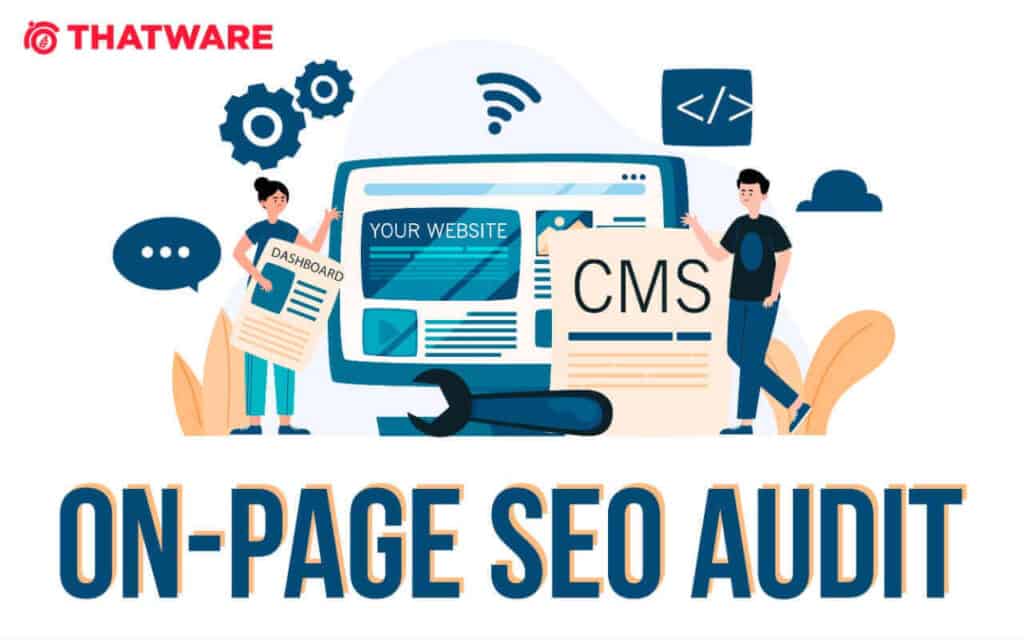
Introduction to On page SEO audit
We have taken this landing page = https://thatware.co/advanced-seo-services/
We have taken this as Focus keyword = Advanced SEO
Color code’s:
- Red = means Status is not Okay and change is needed
- Yellow = means suggestions have been provided for an approval
- Green = means no action needed and things are fine
Chapter 1 – URL Mapping
Purpose in SEO:
In SEO URL structure should be short, containing no stop words, free from query parameters, the inclusion of target keywords and having fewer paths as possible, and having a meaningful intent.
Current observation:
The current URL structure is: /advanced-seo-services
Status:
The URL structure is fine as it’s short and contains no query parameters. Moreover, it also contains the target keyword. Hence, the status is good, no action needed!
Chapter 2 – Metadata
Purpose in SEO:
The meta title should be within 55 characters and must contain keywords and the meta description should be with 155 characters and should contain a variation of the keyword or vice versa.
Current observation:
Current Meta Title: Advanced SEO Services – Thatware
Current Meta Description: N/A
Status:
The landing page doesn’t contain a meta description, which is essential for SEO, and thus it’s not optimized properly. Also, the title is too short and looks spammy. A change is needed here. Consider a free SEO audit report to improve the page’s SEO performance. The current status is not okay.
Meta Title: Advanced SEO Services – #1 Advanced SEO Company | Thatware
Meta Title: Thatware provides exclusive SEO services by blending advanced search engineering, data science, AI, and much more. Thatware is also recognized as the #1 top-rated SEO agency!
Chapter 3 – Page Source Code Robots
Purpose in SEO:
A page source should have the robot’s instructions as followed and an index command should be allowed. This will ensure that the page can be easily followed and indexed by Spider in Google. On-page SEO audits report online should always be conducted page-wise as meta robots can differ in functionalities if tested from the domain level.
Current observation:
As per the screenshot below, there is a robot condition declared on the website.

Status:
Since robots have been declared on the page source, hence no action needed. Status is ok!
Chapter 4 – Mixed Content request
Purpose in SEO:
If a page opens or loads with both HTTP and HTTPS versions, then there is an issue as it might lead to the mixed content issue. It’s advisable to use this code on the source code to prevent this issue:
< meta http-equiv=”Content-Security-Policy” content=”upgrade-insecure-requests” >
Current observation:
The website has the Mixed content prevention code within the page source

Status:
The source code contains the suggested code hence no action needed, status is ok!
Chapter 5 – Open graph protocols with feature Image
Purpose in SEO:
OGP or open graph protocols serve as a good source of social visibility and do reflect on proper brand visibility and SEO ranking factors. Hence, it’s advisable to use the OGP protocols within a source landing page. And the feature image is also important as it serves as the main entry point image to the spiders.
Current observation:
Open https://developers.facebook.com/tools/debug/ and paste the landing page as shown in the screenshot below:

Then click on debug and click on “fetch new information” and check whether the title, description, and feature images are being shown. If it is shown, then we have a Feature image and OGP tags on the website else no.

Status:
As seen from the above screenshot, the OGP protocols are missing. Hence, the status is not Okay, we need to declare the OGP values in the page source. For WordPress, it can be done by Yoast and for manual, it needs to be placed manually in the header. Try using the below format and fill in the details and submit as instructed.
<meta property=”og:title” content=”Advanced SEO Services – #1 Advanced SEO Company | Thatware” />
<meta property=”og:description” content=”Thatware provides exclusive SEO services by blending advanced search engineering, data science, AI, and much more. Thatware is also recognized as the #1 top-rated SEO agency!” />
<meta property=”og:url” content=”https://thatware.co/advanced-seo-services/” />
<meta property=”og:image” content=”https://thatware.co/wp-content/uploads/2020/06/advanced-seo-768×479.png” />
Chapter 6 – Geo Tag
Purpose in SEO:
Geotag provides exposure to local search and boosts GMB performance.
Current observation:
No GEO tag was found in the source code
Status:
The status is not good as no GEO tag have been found on the source code.
Visit: https://www.geo-tag.de/generator/en.html and paste your address
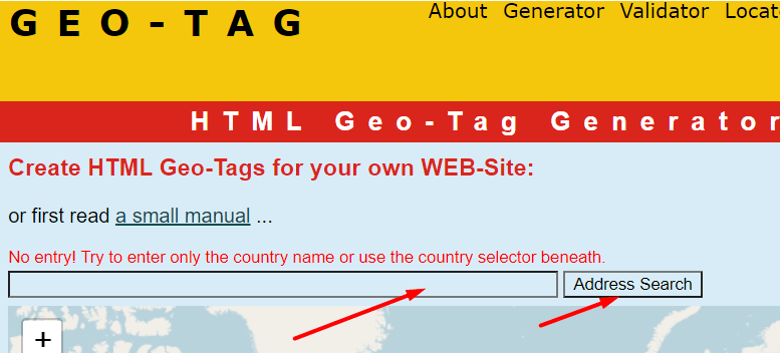
Then click on “Address search” below is the code which you will get as a GEO tag and this needs to be implemented on <head> of the website.
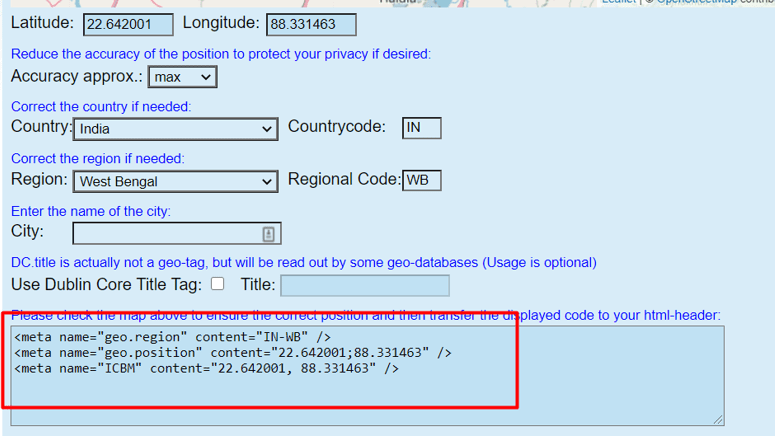
Chapter 7 – Page mobile-friendly test
Purpose in SEO:
This is one of the most vital parameters of SEO. This ensures if the landing page is mobile-friendly or not. Since Google now follows the “Mobile-first indexing” rule. Hence, having a mobile-friendly site is a must!
Current observation:
Visit: https://search.google.com/test/mobile-friendly and test the URL to check out the data provided by the tool. We have done a similar test and below is what we receive in our result. Make sure to also check “if no loading issues persist” and also check the “Screenshot” to make sure the rendered page has no issues.

Status:
No action needed, the page is mobile friendly.
Chapter 8 – Robots.txt tester
Purpose in SEO:
This is a very basic yet effective test. This test ensures that the page is not blocked by Robots in any way possible. This serves as a very important factor for on page SEO audit.
Current observation:
Visit: https://www.google.com/webmasters/tools/robots-testing-tool
Make sure the Google search console is integrated else this feature will not work.
After that choose your domain name and hit the test button. After that, you will get a screen like this as shown below:
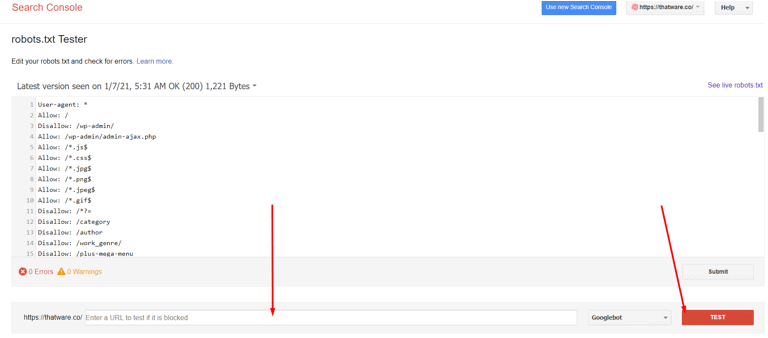
Enter the path and click on “test”
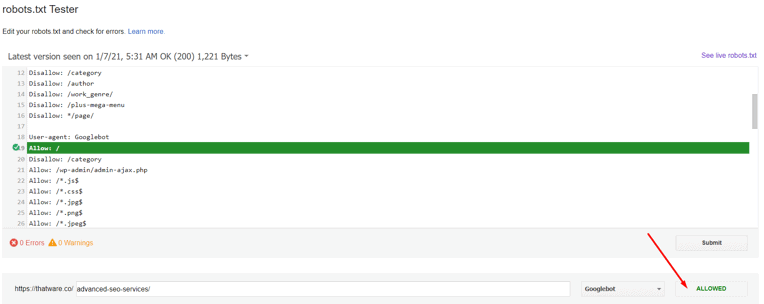
In our case, we have got “Green Allowed” as shown in the screenshot above!
Status:
No action needed. The URL is not blocked by the robots.
Chapter 9 – GSC fetch check-up (Live testing)
Purpose in SEO:
This functionality is used to test the URL fetch statistics. In other words, this is used to check if the URL has been fetched properly without any issues. Please note, we will be doing Live testing.
Current observation:
The first step is to paste the URL on the URL inspection bar. Check the below screenshot for reference.
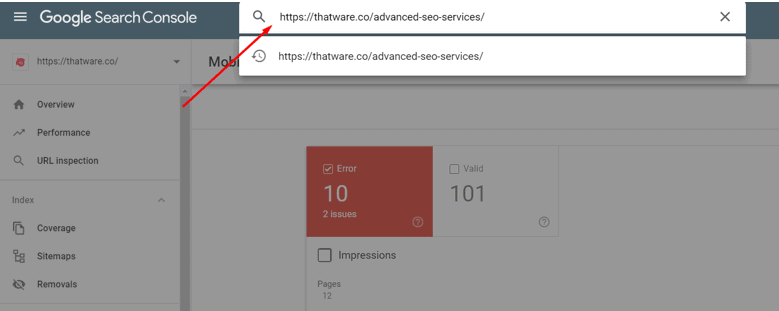
After that click on “Test Live URL”. Please check the screenshot below:
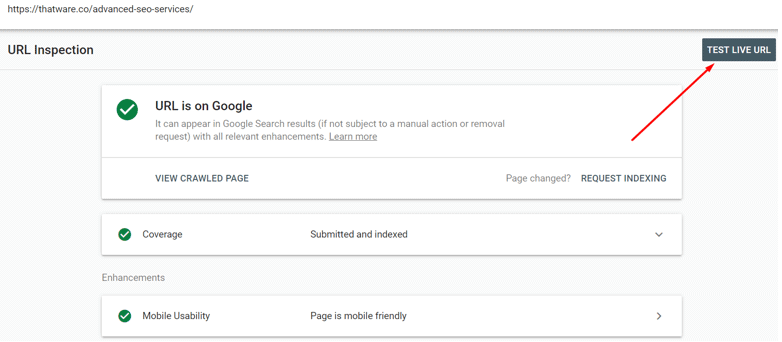
Once the “Test Live URL” has been fetched this will show the current status of the URL as to whether it’s free of any errors or not. Check the below screenshot which we obtained in the final stage.
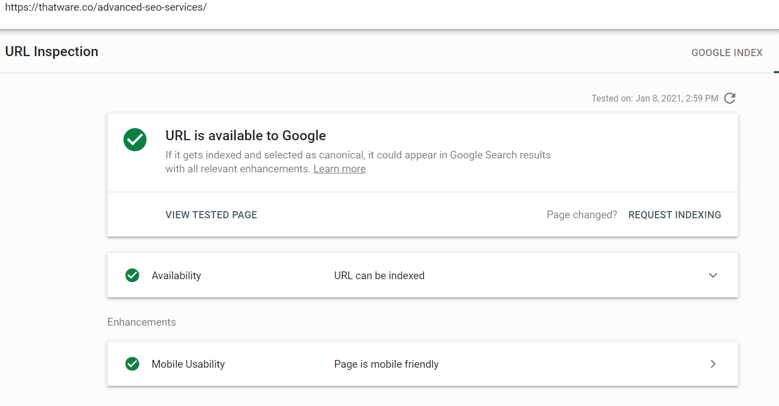
Status: As seen from the below screenshot, the Live test is successful as fetch and crawl are allowed on the URL and also there are no issues during the rendering. Hence, no action needed. Status is ok!
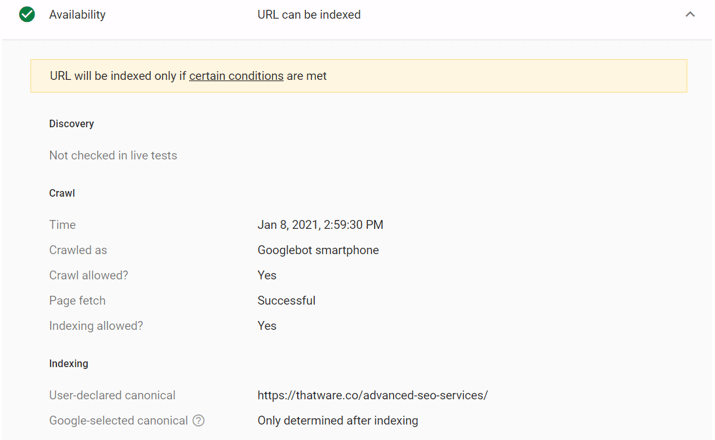
Chapter 10 – XML sitemap inclusion (live testing)
Purpose in SEO:
The purpose of this procedure is to ensure the URL is available on Sitemap (XML) and also follows all the protocol order.
Current observation:
We have opened our Sitemap from https://thatware.co/sitemap.xml and have checked whether our landing page is available or not. And we have found that the URL is available on our XML version and also the protocols are there as well.
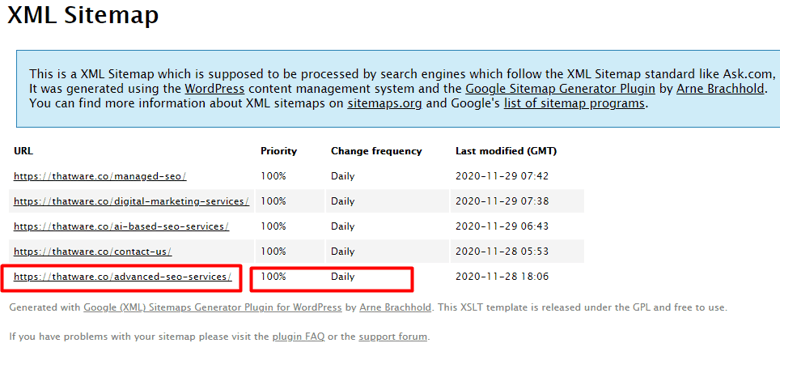
Status:
The URL is present in the XML sitemap and also the protocols are being followed. Hence, no action needed, Status is ok!
Chapter 11 – H-tags check-up
Purpose in SEO:
In SEO the existence of H1, H2, and H3 should be adhered. The rule is as under:
H1 should contain the Focus keyword and must be one in quantity
H2 should contain the LSI variation
H3 should contain the Long tail variation
Current observation:
For the H1 tag, the protocol is followed as it contains the focus keyword! Check the screenshot below for confirmation. Also, the number of H1 must be one!

Quantity of H1

For H2 tag, the protocol is followed as it contains the LSI keywords! Check the screenshot below for confirmation.

For the H3 tag, the protocol is followed as it contains the long-tail keywords! Check the screenshot below for confirmation.

Status:
H1 is Ok
Quantity of H1 is Ok
H2 is Ok
H3 is Ok
Chapter 12 – Anchor text & Internal link check-up
Purpose in SEO:
Anchor text is an essential part of SEO. It helps spiders to effectively communicate the topic of the page. It also helps to set-up the internal link structure as well. Some common rules are as under:
- Anchors should have brand name
- Anchors must use variations of the focus keyword such as LSI
- Anchors should not be an exact match keyword copy which is targeted for the page
Current observation:
No anchor’s found!
Status:
Please use the below anchor texts to link to other pages based on relevance. The relevance pages are as under respectively:
- “technical SEO Services” ——> Should link to —–> https://thatware.co/technical-seo/
- “On-site SEO Services” —> Should link to —–> https://thatware.co/on-page-seo-practices/
- “Advanced SEO specialist” ——> should link to —> https://thatware.co/advanced-seo/
- “Thatware” —-> Should link to —> https://thatware.co/

Chapter 13 – Duplicate content check-up
Purpose in SEO:
Duplicate content is a great threat to SEO. For having the best SEO score, landing pages must use Plagiarism free content.
Current observation:
Visit: https://www.duplichecker.com/ and test the landing page by putting the content.
As seen from the below screenshot, we have 86% unique content.

Status:
Since we have 86% of unique content. Hence, no action needed. Status is Ok!
Chapter 14 – In-links check-up
Purpose in SEO:
In-link is a reverse internal linking strategy that works on the principle of SILO architecture. The strategy basically involves getting incoming links from other pages within the website.
The mechanism should be as the no. of incoming links should be > than the no. of internal links.
Current observation:
As tested from screaming frog spider:
The Out link value = 138
The In-link value = 251, hence the In-link data is good!

Status:
The in-link status is good. No action needed. Status is Ok!
Chapter 15 – External link check-up
Purpose in SEO:
As per the “page rank sculpting” rule in SEO. There must be at least one external link within the landing page linked with a high authority website. This will help with SEO score.
Current observation:
We have an external link on the landing pages linked with “SEO” —à https://en.wikipedia.org/wiki/Search_engine_optimization

Status:
No action needed, there is an external link linked to a high authority website. The status is ok!
Chapter 16 – LSI check-up
Purpose in SEO:
LSI keywords are an important part of SEO. They are responsible for the organic and semantic growth of a website.
Current observation:
The landing page is optimized with LSI as traces of LSI keywords have been spotted!
Status:
No action needed, status is ok!
Chapter 17 – Short passage for the featured snippet
Purpose in SEO:
Short passages throughout the landing page will help to optimize for a wide variety of features such as voice search, passage indexing and featured snippet.
Current observation:
We have observed several passages throughout the landing pages having word counts between 40 – 60.
Status:
No action needed, status is ok!
Chapter 18 – Schema mark-up basic and advanced
Purpose in SEO:
Schema mark-up is very essential and should be implemented as it helps search engines to understand more about the context of the landing page.
Current observation:
As tested from https://search.google.com/structured-data/testing-tool/
We have found that there is no schema within the website. Check the screenshot below:

Status:
Status is not good, basic schema is missing.
It’s our advice to include the following on the schema to ensure proper justification on the purpose:
- Organization
- Local business
- NAP details
- Landing page content information
- FAQ
- Additional contents
- Additional author information’s
Chapter 19 – Self-referential Canonical check-up
Purpose in SEO:
Self-referential canonical tags are the tags that are used in the landing page with the same version of the URL with a slash ending in the URL. For example:
www.example.com should have a self-referential canonical tag as
< link rel=”canonical” href=”https://example.com/” / >
Current observation:
When we checked the source code of the page, we found that the self-referential canonical tag is contained. Please check the below screenshot!

Status:
No action needed, status is ok!
Chapter 20 – Web vitals check-up
Purpose in SEO:
WEB vitals are the future of SEO. These are the technical parameters that judge the user’s interactivity vital points! In other words, it’s a measure of user experience on your landing page.
Current observation:
Tested from GTMETRIX, below is the screenshot!

Status:
No action needed. Status is ok!
Chapter 21 – GTMetrix check-up
Purpose in SEO:
GTMetrix serves as an important source to understand the speed-related purpose of a campaign.
Current observation:
Tested from GTMETRIX, below is the screenshot!

Status:
No action needed. Status is ok!
Chapter 22 – TTFB check-up
Purpose in SEO:
TTFB stands for “Time to First Byte”. This indicates how fast does a website need to load 1 Byte. The ideal range is below 500 ms. This is a very important SEO ranking factor.
Current observation:
Visit https://www.webpagetest.org/ as seen from the below screenshot, TTFB = 182 ms.

Status:
No action needed. Status is ok!
Chapter 23 – Safe browsing check-up
Purpose in SEO:
Google safe browsing is a way to measure whether a given site is free from Malware and malicious files. This will ensure safe browsing for users and it helps for ensuring proper SEO score.
Current observation:
Visit: https://transparencyreport.google.com/safe-browsing/search?hl=en and search with the landing page

Status:
No action needed. Status is ok!
Chapter 24 – JS rendering
Purpose in SEO:
The purpose is to check whether a webpage loads by disabling all JS. This ensures smooth JS rendering which is an essential part of on page audit in SEO.
Current observation:
Download chrome developer’s tool and click on “disable JavaScript” and load the page once again! Look the screenshot below.

Check the below screenshot, this is the first fold view of the website by keeping JS disabled. But the UX is unhampered. This proves that JS rendering issue is not an issue here!

Status:
No action needed. Status is ok!
Chapter 25 – Latest Crawl status check
Purpose in SEO:
This is to check and ensure the landing page is frequently crawled at least within the last 4-5 days. Beyond that would indicate a poor crawl rate for the website which is not good for SEO.
Current observation:
Once again go to GSC and click on URL inspection and search the URL and then click on “Coverage”

Status:
As seen from the above screenshot, the last crawl date was 6th Jan and the time of reporting this report is the 8th of Jan, hence the crawl status is ok.
You can read more about crawl optimization here: https://thatware.co/crawl-budget/
Chapter 26 – Request protocol check-up
Purpose in SEO:
Protocols are HTTP requests which tell search engines about the status of the page. Some of the common protocols are as under:
- 2XX = Successful status
- 3XX = Redirection status
- 4XX = Not found status
- 5XX = Server error status
The main thing to look forward is to ensure that the given landing page doesn’t contains any of the following:
- No 4XX errors
- No 302, 307 etc. but can contain 301 errors
- No redirect chains
- No server errors
- If 2XX obtained, then it’s good to go!
Current observation:
As seen from Screaming frog spider under the “Response codes” tab, we get the below result which states the page is 200

Status:
No action needed. Status is ok!
Chapter 27 – Index status using the site: search
Purpose in SEO:
This is one of the very basic yet an important aspect of on page SEO audit. Index status report ensures that the given landing page is indexed by site: command
Current observation:
Put this command in Google search, check screenshot below.

Status:
We get the index result snippet after the site command. Hence, no action needed, status is ok!
Chapter 28 – Image Alt tag check-up
Purpose in SEO:
An ALT tag is a must for all the images present within a landing page. An ALT tag is a part of the SEO ranking factor and helps in improving the image search visibility. When an On page SEO audit is conducted on a page having multiple images then all the images must contain an ALT tag!
Current observation:
First of all, we see that the landing page contains only 1 image. Then we have inspected and checked the image path. And found no ALT tag. Check the screenshot below:

Status:
ALT tag is missing; hence the status is not good.
Please put Alt text = “Advanced SEO services” as the ALT tag
Chapter 29 – Image optimization
Purpose in SEO:
Image optimization includes checking the size of the image so that it doesn’t become too large else it will cause slow loading of the page. When an on page SEO is conducted for a page having multiple images then the combined size shouldn’t exceed 3 MB
Current observation:
Download the image and check the size.
In our case, we found the size to be 32.5 KB which is perfectly fine. Check the screenshot below!

Status:
No action needed, status is ok!
Chapter 30 – Crawl depth check-up
Purpose in SEO:
Crawl depth is the number of clicks needed to visit the landing page from the homepage. The ideal score is to keep within 3.
Current observation:
Open Screaming frog and check the value, in our case the value is 0 as seen in the screenshot below:

Status:
No action needed, status is ok!
Chapter 31 – Content check-up
Purpose in SEO:
The basic golden rule is that the landing page content should be more than 1000 words. Content word count is a vital parameter to judge the on page SEO audit success.
Current observation:
Visit: https://www.seoptimer.com/website-word-count and check the word count & check the screenshot below! The word count is 3691

Status:
No action needed, status is ok!
Chapter 32 – Same page linking
Purpose in SEO:
The same page internal link makes an important SEO improvement as it helps to effectively distribute the topic idea about the landing page in search engines. The same page anchor must be closely related to the focus keyword or the focus keyword itself.
Current observation:
No such link found
Status:
Check the below screenshot, make it hyperlink to the same landing page itself

<strong>Chapter 33 – Longtail check-up</strong>
Purpose in SEO:
Long keywords are an important part of SEO. They are responsible for the organic and semantic growth of a website. It also helps in improving intent signal as well
Current observation:
The landing page is optimized with long tail as traces of long tail keywords have been spotted!
Status:
No action needed, status is ok!
Chapter 34 – Hyper-Intelligence SEO Integration
Purpose in SEO:
Hyper-Intelligence SEO is the next evolution in website optimization, combining AI-driven insights, predictive analytics, and advanced automation to enhance both content and technical SEO. Unlike traditional audits, Hyper-Intelligence SEO continuously monitors a website in real-time, detecting minute performance gaps, semantic keyword opportunities, and potential UX issues before they impact rankings. By integrating machine learning algorithms, this approach enables smarter decision-making, faster problem resolution, and more precise targeting of high-value search queries.
Implementation Approach:
To implement Hyper-Intelligence SEO, begin by connecting AI-powered tools to your website’s analytics and search console data. These tools analyze user behavior, crawl patterns, and search engine signals to provide actionable insights. For example, AI can recommend content adjustments to match emerging search trends, optimize internal linking structures, and even generate metadata suggestions for underperforming pages. Predictive modeling helps anticipate potential crawl errors or indexing issues, allowing preemptive corrections that maintain SEO health.
Benefits:
- Proactive Issue Detection: Identify technical or content-related issues before they affect rankings.
- Smart Content Optimization: AI suggests keyword placement, semantic variations, and long-tail opportunities based on real-time search trends.
- Enhanced User Experience: Hyper-Intelligence SEO evaluates page performance metrics, such as Core Web Vitals, and provides actionable UX improvements.
- Data-Driven Decisions: Leverages predictive analytics to prioritize changes with the highest SEO impact.
Current Observation:
Websites adopting Hyper-Intelligence SEO are seeing faster improvements in search visibility, higher engagement metrics, and better alignment with Google’s AI-driven algorithms. By combining this approach with traditional on-page audits, businesses can maintain both foundational SEO health and forward-looking optimization strategies.
Status:
Integration recommended for progressive SEO strategy. Implement AI monitoring and predictive optimization alongside routine audits for maximum effectiveness.
Advanced On-Page Audit Insights for Modern SEO Success
While traditional on-page SEO focuses on fundamentals like meta tags, headings, and content structure, modern search engines evaluate far deeper signals to determine relevance, trust, and user satisfaction. An advanced on-page audit goes beyond surface-level checks and examines the behavioral, semantic, and experiential elements that influence rankings holistically.
One critical component is search intent alignment. Even the most optimized page may underperform if the content does not fully match what users expect when they search for a query. A high-quality audit investigates intent gaps, identifies mismatched keywords, and adjusts page messaging, depth, and structure to satisfy informational, commercial, navigational, or transactional needs more accurately.
Another vital factor is entity recognition and semantic strengthening. Today’s algorithms rely heavily on Natural Language Processing (NLP) and machine learning to understand topics, relationships, and context. A thorough audit ensures that key entities are clearly defined, properly linked, and supported with relevant context, helping the page become more discoverable in AI-powered search environments.
Modern audits must also evaluate UX behavior signals. Metrics such as scroll depth, interaction rate, bounce patterns, and content readability influence how search engines interpret engagement quality. Optimizing layout flow, adding supportive visuals, improving paragraph density, and providing interactive elements can significantly enhance performance.
Furthermore, a comprehensive review includes technical content health, such as schema compliance, accessibility attributes, internal link equity distribution, and mobile interaction quality. These behind-the-scenes elements shape how efficiently crawlers interpret your page and how easily users navigate it.
By combining traditional SEO with advanced semantic and behavioral optimization, an in-depth on-page audit ensures every page is future-ready—fully aligned with how modern search engines evaluate authority and user satisfaction.
Conclusion
If you follow the above protocols for an on-page SEO audit, it will significantly enhance the SEO performance of your landing page. A comprehensive SEO audit ensures that every element of your website, from content to technical aspects, is optimized for search engines. By implementing these strategies, you can improve your website’s visibility, ranking, and user experience. Try out the tips provided, conduct a thorough SEO audit, and let us know your results! This continuous process of auditing and optimization is key to maintaining long-term SEO success and achieving your desired digital marketing goals.

